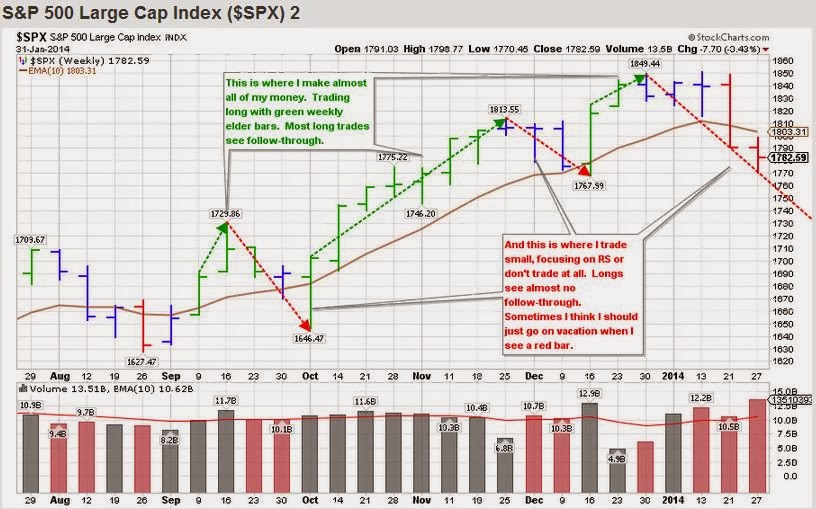Let's start with a throwback to
2007 - right before the crash...
Here's what the NYSE looked like in
2007:
OK, fast forward to present time (March 16th, 2014) and take a look at the INDU's. Obviously, there's some major differences between the 2007 $NYA and 2014 $INDU's, but the structure is remarkably similar. PPO lines show similar negative divergence w/price. You have a left side "doublet", a swoosh down to the 30w (150d) EMA, recovery and failure. Although the sequence isn't aligned exactly, it's close. History doesn't repeat, but it often rhymes. Significantly, what we don't have yet is the "panicky" volume that came in 2007. Still worth watching.
So what, you say. It's only 30 stocks. It's a statistical sampling error that's revised every few years by a bunch of grumpy old men to make it even less consequential or reliable. OK, let's look at some other charts from the US and around the world.
How about retail? That's an important US sector, right? We're supposedly a retail-based economy. After a blistering run, I see a series of lower highs here. Can't argue with price until we see a higher high.
And where's the leadership coming from now? Utilities. Ugh. I'd rather staples and low-vol lead, than utes. Anything but the 'utes.
It's not all bad. US small caps are making higher highs with volume. That's bullish. Price is still above the 10w EMA. Elder bars are green. There's still that pesky, omnipresent PPO negative divergence with price, but there's really nothing terribly wrong with this chart.
Here's another example of the negative divergence with higher prices. This time courtesy of the $NDX, but $SPX, $NYA, XLF, etc. all look similar with "-ve D". The $NDX is looking a little less perky than small caps, but still no lower highs here.
The rest of the world doesn't look nearly as strong, though. Emerging markets, Japan, & Europe (led down with H&S top in Germany) are all weaker.
Volatility is picking up and PPO didn't even get back below zero during this latest run up in equities. We're not even at the magic 21 level yet, so plenty of room for more upside. IF the 22 level should fail, this one could run significantly higher - a possibility that not many people will expect.
And what the
f*ck heck is up with copper? Dr. Copper did an excellent job of sniffing out the 2007 top and subsequent bottom in 2008-2009 right around when China and Brazil bottomed....but well before the March 2009 bottom in US equities. So, why is it back to 2009 levels? Why are we breaking important support levels with volume? Imagine how low it would be with a stronger dollar! Yikes. What is copper's problem? What is it sniffing out this time? $2.81 is the next level to watch here with important support from 2009 and 2010.

Continuing with metals, gold is looking much better than it has in YEARS. Remember the persistent verbal bashing gold took last year? Everybody's favorite whipping boy. "Why own gold when you can own a cow?" How it is going below $1000 and doesn't belong in anyone's portfolio? All that rot. I haven't heard much from those people this year. Here's the take-away: no trend lasts forever and sentiment is a powerful contra-indicator. Coffee, anyone? Anyway, the acceleration off the double bottom is continuing. PPO is crossing the zero line (just barely, but still positive). The 10w EMA closed above the 30w EMA for the 1st time in over a year. The next important level is $1399.90 and that looks like it will be tough to break on the 1st push. A pause at the level would be good as indicators look poised for higher prices.

Gold & silver miners are moving up with gold. PPO lines & EMA's are looking bullish. The next important level is $112.12. Similar to gold, a pause around that level to digest gains would be good as long as indicators remain strong.
Forget the headlines of the bond bubble is over. Look at this chart of the 20+ year treasury bond fund. It's working on a PPO zero-line x-over. EMA's are threatening to cross. And price is banging away on $108.73. This does not look bearish to me. I'm not saying that it's a new bull in the bond market, but this thing could retrace 50% - that's a nice bounce from these levels.
So what does it all mean? From these charts, I can tell where I want to be buying dips or positioned long: gold, miners, bonds, maybe utes (ugh) and maybe small caps. And I see lots of areas that I want to avoid namely, anything ex-US. For my own trading, I'm raising cash, nibbling on some index hedges, but still trading long (mostly half-size) and taking profits faster than usual. Everbody's trading plan is different depending on time frame, flexibility and comfort level, so what works for me may not work for you.
Thanks for looking.
For more charts, please see my public chart list on stockcharts.com:
http://stockcharts.com/public/1109955


















































